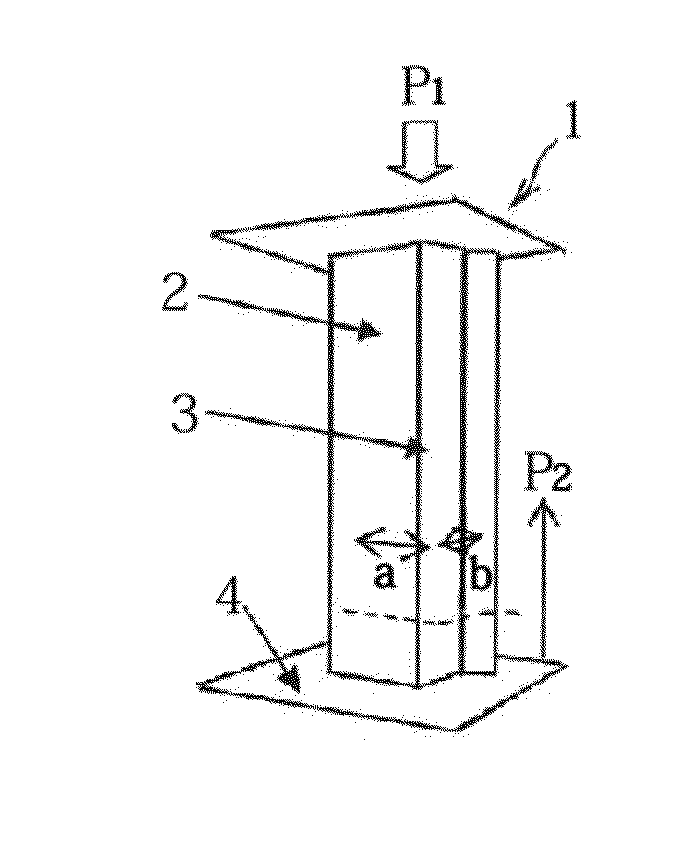Impact-absorbing component
a technology of components and components, applied in the direction of shock absorbers, springs/dampers, elastic dampers, etc., can solve the problems of insufficient cruising distance, difficult to achieve a large increase in absorption energy, difficult to make components more compact and achieve weight reduction, etc., to achieve easy and efficient maintenance, increase the weight of peripheral members, and increase fuel efficiency
- Summary
- Abstract
- Description
- Claims
- Application Information
AI Technical Summary
Benefits of technology
Problems solved by technology
Method used
Image
Examples
first exemplary embodiment
[0078]The present exemplary embodiment is an impact absorbing component that absorbs impact energy when impact load is exerted onto the component at one end portion in the impact absorption direction. The impact absorbing component is configured including a member formed into a profile including at least two ridge lines, by working a laminated metal sheet of uniform cross-section configured by lamination bonding sheet metal onto both faces of a core layer having appropriate Young's modulus and density. In the present specification, in cases in which an impact absorbing component has straight line portions in the profiles of cross-sections orthogonal to an impact absorption direction of the impact absorbing component, a ridge line is a line connecting the angled portions (having an angle of over 0° but less than 180°) formed between the straight line portions along the impact absorption direction (see the ridge line 3 in FIG. 1).
[0079]As illustrated in FIG. 3, a laminated metal sheet...
first examples
[0147]Explanation regarding the invention follows, based on specific examples and comparative examples.
[0148]Configuration of Employed Laminated Metal Sheet and Manufacturing Method
[0149]Laminated metal sheets configured with the surface layers and the core layers listed in Table 1 were manufactured as examples and comparative examples of the present invention. Bonding between the surface layers and the core layer was achieved using a structural adhesive (base: epoxy resin, coating amount 200 g / m2), an instant adhesive (base: cyanoacrylate, coating amount 200 g / m2), brazing filler metal (Sn—Pb based low temperature braze, melting point 183° C., usage amount 15 g / m2).
TABLE 1Configuration ofSurface LayersCore LayerLaminatedLaminatedThicknessThicknessMetal SheetMetal SheetSubstance(mm)Substance(mm)Ec / Eftc / tfAAl Killed0.3Wire Mesh1.45.5 × 10−24.7SteelBAl Sheet0.3Polyester1.45.5 × 10−24.7CAl Killed0.3Polypropylene1.43.2 × 10−34.7SteelDAl Killed0.3Wire Mesh3.15.5 × 10−210.4SteelEAl Killed...
second exemplary embodiment
Summary
[0190]The impact absorbing components according to the present exemplary embodiment are configured from a member formed by working a laminated metal sheet of uniform cross-section configured by lamination bonding surface layers made from a metal sheet having a higher Young's modulus than that of a core layer onto both faces of the core layer, with a sheet thickness ratio (tc / tf) of the sheet thickness of the core layer (tc) to the sheet thickness of the surface layers (tf) of the laminated metal sheet of from 2.0 to 7.0. Such an impact absorbing component has high impact energy absorption efficiency and is able to achieve a large weight reduction even though it has a simple profile.
[0191]Specifically, the bucking wavelength can be made shorter by making the sheet thickness ratio (tc / tf) of the sheet thickness of the core layer (tc) to the sheet thickness of the surface layers (tf) of the laminated metal sheet from 2.0 to 7.0. Thus the impact absorbing component formed from a ...
PUM
 Login to view more
Login to view more Abstract
Description
Claims
Application Information
 Login to view more
Login to view more - R&D Engineer
- R&D Manager
- IP Professional
- Industry Leading Data Capabilities
- Powerful AI technology
- Patent DNA Extraction
Browse by: Latest US Patents, China's latest patents, Technical Efficacy Thesaurus, Application Domain, Technology Topic.
© 2024 PatSnap. All rights reserved.Legal|Privacy policy|Modern Slavery Act Transparency Statement|Sitemap



